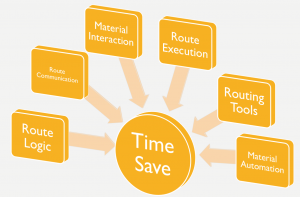Routing Theory
Routing Theory is an examination of the components that make up a time save in a speedrun. The concepts covered in this article were developed within the PRCLive community and do not represent an overall philosophy of the speedrunning community at large.
Components

Throughout the process of creating and improving the Oblivion 100% Completion Speedrun, several successes and failures have helped to form a better idea of what components make a speedrun successful.
The end result of a successful speedrun is a measurable Time Save. The Time Save on the surface would appear to consist of improving route logic and then executing a speedrun using that route logic, but there are a significant number of other components that have proven to result in a more significant Time Save. These components are the following:
- Route Logic — One of the most obvious components. This is the actual order that objectives are achieved in, as well as the tech and glitches used to perform these objectives.
- Route Execution — The other obvious component. This is the actual playing of the game, which can be optimized within itself for each version of Route Logic.
- Route Communication — This is the manner of expressing the Route Logic to players, ranging from simple things like wording and color-coding, to more complex ideas like auxiliary handbooks and maps. This is a very important component not only for teaching new runners a route, but also keeping runners on track for highly technical Route Logic. The better the Route Communication, the less memorization is required by the player.
- Material Interaction — This is the usability of the route materials. A good example to illustrate this component is the Nirnroute in the Oblivion 100% run. Despite the Route Communication being highly effective at showing the player which Nirnroot to collect using images and text, the system of needing to change pages on a PDF, check locations off on a map in an image editor, and checking the objective off in the checklist makes for an extremely inefficient system that is prone to errors.
- Material Automation — This is the process of reducing the Material Interaction wherever possible. Using things like webpages and save file readers to more automatically display and check off objectives can drastically reduce workload required to update progress mid-run.
- Routing Tools — This is the process of creating programs and other tools that can aid in finding new routing possibilities, tech, glitches, etc. An example of this would be a traveling salesman algorithm to calculate the optimal pathing for map exploration.